Author: @DiogenesCasares
Compiled by: Vernacular Blockchain
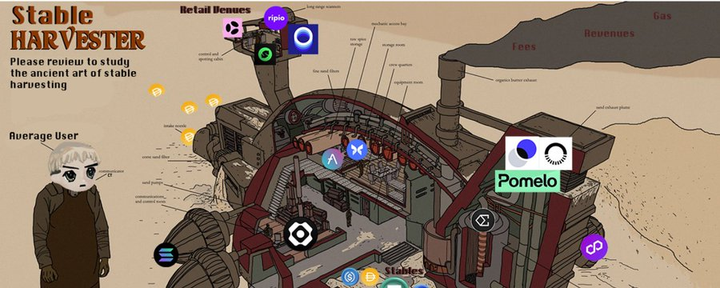
Stablecoins account for two-thirds of on-chain transaction volume, whether used for exchange, DeFi trading, or simple transfer payments. Initially, stablecoins gained attention through Tether, the first widely used stablecoin. Tether was originally created to solve the problem that Bitfinex users could not easily use fiat currency due to bank account restrictions. Bitfinex created USDTether and promised to be 1:1 backed by the US dollar. Since then, Tether has spread rapidly, and traders use USDT to conduct arbitrage transactions between different trading platforms. Compared with traditional bank wires that take several days to complete, Tether transactions can be confirmed in just a few blocks (minutes), making USDT a highly advantageous payment tool in the crypto market.
However, while stablecoins were originally created to solve specific problems in the cryptocurrency ecosystem, they have now transcended their original purpose and become a core driver of everyday money transfers, and are increasingly being used to earn yield and facilitate real-world transactions. Currently, the total market value of stablecoins accounts for about 5% of the cryptocurrency market. If we take into account the companies that manage these stablecoins, or blockchain networks like Tron that are primarily valued based on stablecoin usage, the overall market share of stablecoins is close to 8%.
Despite the rapid growth of stablecoins, there is relatively limited content on why stablecoins are so popular. Tens of millions of users are replacing the traditional financial system with stablecoins, but little is known about the real drivers. In addition, there is even less research on the platforms and projects that support the development of the stablecoin ecosystem and the different user groups. Therefore, this article will delve into why stablecoins are so popular, who are the main players in the stablecoin field, and which user groups are driving this trend, and analyze how stablecoins are gradually becoming the next stage of monetary evolution.
1. A brief history of the US dollar
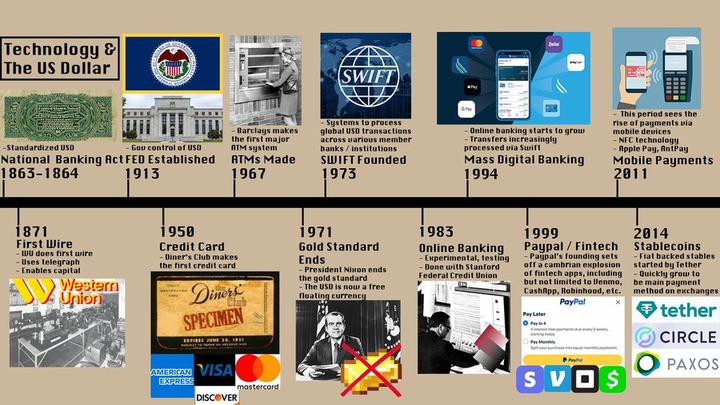
When you think of “money,” what do you think of? Cash? Dollars? Price tags at the supermarket? Taxes? In these contexts, money is essentially an agreed-upon unit of measurement used to measure the value of a variety of different, heterogeneous goods and services.
In the beginning, money was in the form of shells and salt, which then evolved into copper coins, silver coins, gold coins, and now the US dollar/fiat currency.
1) Let’s focus on the US dollar
The US dollar (and modern fiat currencies, which are currencies issued by governments and not backed by real assets) have gone through several stages of development. In the United States, the original US dollar notes (paper money issued by banks) were privately owned. At the time, individual banks were free to print money, a model somewhat similar to the Hong Kong dollar (HKD) system in Hong Kong. However, due to the many problems with this model, the government eventually stepped in and took over the issuance of the US dollar, while also passing laws to peg the dollar to gold.
In 1871, Western Union used the telegraph to complete the first wire transfer, achieving a breakthrough in transferring funds without moving large amounts of paper money. This innovation greatly improved the efficiency of the financial system because it eliminated the physical constraints on the circulation of money, making the entire financial system more efficient.
2) A brief history of the development of the US dollar
1913: The Federal Reserve System was established and began to regulate the issuance of US dollars and monetary policy.
1971: Nixon ends the gold standard, which no longer pegs the dollar to gold and moves to a free-floating currency system.
1950: The world's first credit card was born, ushering in the era of non-cash payments.
1973: The SWIFT (Society for Worldwide Interbank Financial Telecommunication) payments network is established, making U.S. dollar transactions faster and more global.
1983: The first digital bank account is established at Stanford Federal Credit Union, kicking off the digitalization of banking.
1999: PayPal is born, enabling purely digital payments without the need for a bank account.
2014: Tether launches the first dollar-backed stablecoin (USDT), laying the foundation for today’s stablecoin market.
All of this development has brought us to the current era of stablecoins.
The most important thing this brief historical review reveals to us is that the form of money and the way we use it are always changing.
Today, it’s perfectly feasible to pay $20 via PayPal, cash, Zelle, or bank transfer (although you’ll probably get some weird looks if you use a traditional bank transfer). The same trend applies to stablecoins in the developing world, and increasingly in the developed world.
Personally, I get paid in stablecoins, I’ve used stablecoins to exchange for cash, and now I even prefer to use stablecoins instead of bank accounts for savings, and use protocols such as @HyperliquidX’s HLP, AAVE, Morpho, and @StreamDeFi to manage funds.
We live in a world where the traditional financial system often places a heavy burden on the most vulnerable. Capital controls, bank monopolies, and high fees have become the norm. In this environment, stablecoins have become a powerful tool for financial freedom - not only making it easier to transfer money across borders, but they are also increasingly being used to pay directly for goods and services.
To understand how stablecoins have become so successful in such a short period of time, we first need to understand why stablecoins can beat the traditional financial system.
2. Stablecoins vs. Bank Transfers: One City, Two Stories
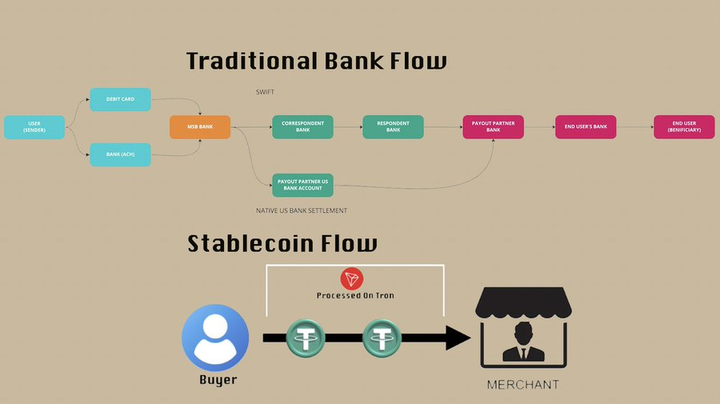
The essence of a stablecoin is a token backed by a fiat currency such as the US dollar or the euro.
Many readers of this article may come from developed countries in North America, Europe, or Asia, where the financial systems are relatively efficient, smooth, and stable. In the United States, there are PayPal and Zelle, in Europe, there is SEPA, and in Asia, various financial technology companies have emerged in an endless stream, the most well-known of which are Alipay and WeChat Pay.
In these regions, people are used to depositing money into banks without worrying about the balance disappearing the next day or worrying about hyperinflation. Small transfers can usually be completed quickly, and even large transfers of funds may take longer, but not unbearably. In addition, most businesses force customers to use the local banking system because it is considered safer and more convenient.
However, in another part of the world, a completely different reality exists.
In Argentina, bank deposits have been forcibly seized by the government on multiple occasions, and the national currency is one of the worst performing currencies in history.
In Nigeria, the official exchange rate is seriously out of sync with the black market rate, making it extremely difficult to move money in and out of the country - ironically, this also applies to Argentina.
In the Middle East, bank accounts may be frozen at will by the government, causing many ordinary people (especially those without political background) to be afraid to deposit most of their liquid assets in banks and have to choose other ways to store funds.
Not only is holding money risky, but transferring money is often more difficult. Cross-border SWIFT transfers are expensive and cumbersome, and most people in these countries don’t have bank accounts for the same reasons.
As for alternatives such as Western Union, while they can complete cross-border remittances, they usually charge extremely high fees (you can check their fee calculator). What's worse, they often settle at official exchange rates, which are often much higher than the actual market exchange rate, resulting in huge "hidden" fees for users.
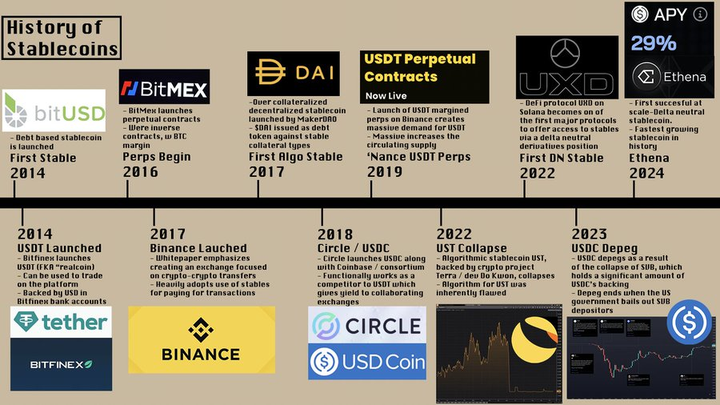
Stablecoins allow people to hold funds outside of their local financial system because they are global in nature and rely on blockchains for transfers rather than local bank servers. This feature stems from their historical background - cryptocurrency exchanges have faced challenges in opening bank accounts, processing large-scale deposits and withdrawals, and transferring money across exchanges.
One of the most famous cases is Japan, where the cumbersome bureaucracy of the Japanese banking system and strict capital controls have led to a long-standing arbitrage space between global cryptocurrency prices and local Japanese prices.
In 2017, BN announced in its white paper that its trading platform would only support stablecoin-cryptocurrency trading pairs to speed up settlement. This move directly promoted the shift of market trading volume to stablecoin trading pairs. In 2019, BN launched USDT perpetual contracts, allowing users to use USDT instead of BTC for margin trading, further consolidating the dominance of stablecoins. Today, stablecoins have become a recognized basic asset in the cryptocurrency market, and this acceptance is gradually expanding to application scenarios beyond cryptocurrencies.
3. Stablecoins vs. Fintech: Speed, innovation, and solutions to global financial problems
If we look at transaction speed, innovative design, and the ability to solve global financial problems, stablecoins are significantly different from Fintech.
So far, the main contribution of FinTech is to optimize and beautify the existing payment infrastructure, rather than completely change its underlying architecture. In essence, they just add a layer of "paint" on the traditional financial system, but do not solve its inherent inefficiency and complexity. Stablecoins are the most significant change in the global financial system in 50 years.
Fast, reliable, and transparent: The transfer speed of stablecoins far exceeds that of the traditional banking system, and they are verifiable on the chain, making the flow of funds more efficient.
Low-cost remittances: Compared to traditional payment methods such as bank wires or Western Union, stablecoins almost eliminate the high fees (although this also means losing some of the protections provided by the traditional financial system).
Competitor to Cash and Payment Processors: Stablecoins are not only an alternative to cash, but also compete with payment processors such as Western Union, while being safer and longer-lasting than cash.
Cannot be easily destroyed or stolen: Stablecoins will not disappear due to floods, fires, or theft like cash, and can be exchanged for local currency at any time.
Extremely low transaction fees: The cost of transferring stablecoins depends on the blockchain network, but is typically less than $2 and is a fixed fee, much lower than the fees of traditional payment systems such as Western Union (usually between 0.65% and more than 4%).
All this shows that stablecoins are not only dominating the cryptocurrency space, but are also challenging the foundations of the traditional financial system.
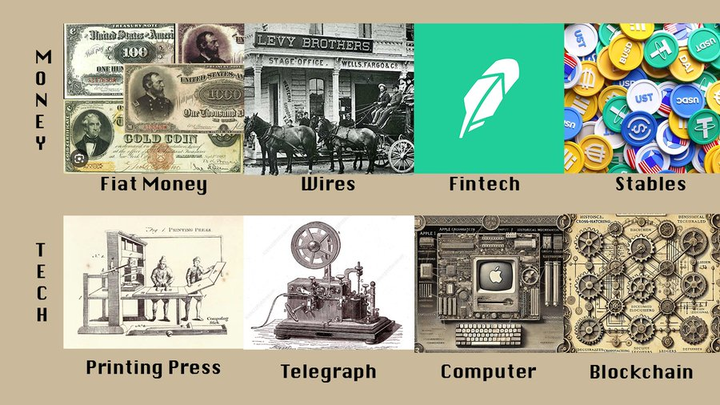
Once stablecoins are widely accepted and mature, they will inevitably fill gaps in the global financial system that traditional financial institutions have not yet covered. As stablecoins continue to gain popularity, the financial services and complex products surrounding them are also growing rapidly.
For example, @MountainUSDM has introduced RWA (real world asset) returns across multiple platforms in Argentina, while @ethena_labs enables users to profit through zero-exposure delta-neutral trades without relying on the traditional banking system or exchange custody.
Today, the use of stablecoins has gone far beyond simple payment processing or hedging, and more and more people are beginning to use stablecoins to earn income or even for local payments. As this trend develops, stablecoins are gradually becoming an important part of global financial planning and are even included in corporate balance sheets.
It is worth noting that many stablecoin users do not even know that they are using crypto technology - this is exactly the huge breakthrough in product innovation around stablecoins in recent years. Major companies continue to optimize the user experience, making the use of stablecoins more seamless and intuitive, further promoting its global adoption.
4. Companies that are promoting the popularity of stablecoins
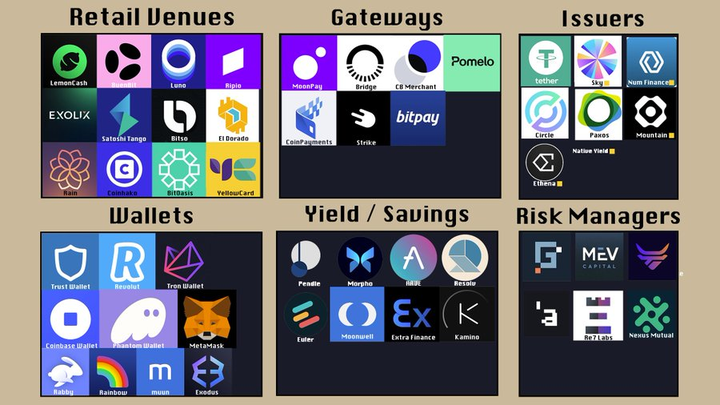
The main stablecoin projects are first and foremost the companies that issue these stablecoins. These include:
USDC issuer @Circle
USDT issuer @Tether_to
DAI/USDS issuer @SkyEcosystem
PYUSD, jointly launched by @PayPal and @Paxos
Of course, there are many more stablecoins that are not mentioned, but these are the most prominent ones for payment purposes. These companies usually have bank accounts, receive traditional bank wires, and convert these funds into stablecoins to provide to users.
1) Stablecoin funding model
Stablecoin issuers hold the funds deposited by users and charge users very low fees (usually 1-10 basis points). Users can transfer these assets at any time, and the issuer earns interest on the funds in the bank account (i.e. "floating income" or "yield" in the DeFi context).
Trading firms play an important role in this process, handling the on/off ramp of fiat-to-stablecoin conversions at scale. As more and more exchanges begin to crack down on users who only deposit and withdraw funds with stablecoins but do not pay transaction fees, the role of trading firms in this market is becoming increasingly critical.
Trading firms often offer better prices than local trading platforms, further improving the efficiency and competitiveness of stablecoins.
As all major trading firms compete fiercely in this market, they continue to optimize liquidity and services to make stablecoin transactions smoother.
Stablecoin issuers earn interest in the process rather than charging users high fees, which is also the core of their business model.
It is worth mentioning that @SkyEcosystem (formerly Maker) has a different model.
SkyEcosystem adopts a hybrid model, with its stablecoin USDS backed by a variety of collateral assets (including other currency reserves).
Users can deposit these collateral assets and borrow USDS at a predetermined interest rate.
They can choose to deposit into the "savings rate module" (similar to the risk-free rate), or borrow USDS on platforms such as @MorphoLabs, @Aave, or simply hold USDS.
This model allows users to choose safer yield options, or take higher risks for higher returns.
2) Stablecoin user growth: not directly for consumers
Currently, most major stablecoin issuers do not directly target ordinary consumers, but indirectly provide stablecoin support through different financial service companies. This model is similar to MasterCard-it cooperates with banks but does not directly connect to end users.
You may rarely hear names like @LemonCash, @Bitso, @Buenbit, @Belo, @Rippio in the crypto community (CT), but they play an important role in the stablecoin trading market. For example:
The above-mentioned Argentine trading platforms alone have more than 20 million KYC-certified users, almost half of Coinbase's users, while Argentina's population is only 1/7 of that of the United States.
Lemon Cash's transaction volume reached $5 billion in 2023, a large part of which was stablecoin-stablecoin transactions, or ARS (Argentine Peso)-stablecoin transactions.
These platforms act as an on-ramp for most non-peer stablecoin trading, and they themselves have a large amount of crypto trading volume and stablecoin deposits. However, with the exception of Rippio, most platforms do not have their own order books and rely on order routing systems to complete transactions.
This model is very similar to Robinhood - Robinhood is not a true trading platform, but routes pricing through liquidity providers (Market Makers). I call these platforms "Retail Venues" because their focus is on optimizing user experience and retail products rather than building their own trading platform infrastructure.
Robinhood’s API does not allow high-frequency traders or market makers to use it because its target users are not professional traders but ordinary investors.
Similarly, BuenBit and Lemon will not attract market makers. Their main target users are ordinary consumers, not professional trading firms or high-frequency traders.
Under this model, the application of stablecoins is entering the global financial system in a low-cost and efficient manner, which not only affects the crypto market, but also changes the landscape of the traditional payment and remittance industries.
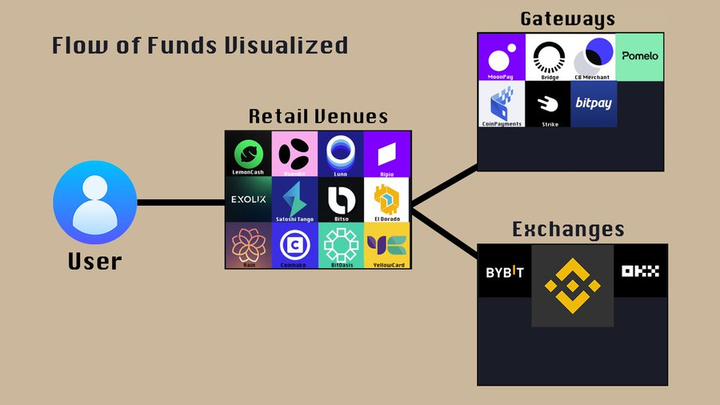
Next, let’s look at the blockchain where stablecoins actually operate, which is where stablecoin transfers, transaction records, and balances are stored. Currently, the main chains for stablecoin transactions include:
@justinsuntron of @trondao (TRON)
@binance’s BN Smart Chain (BSC)
@solana (Solana)
@0xPolygon (Polygon)
The main purpose of these chains is value transfer and does not necessarily involve DeFi interactions or yield generation.
Although Ethereum still leads in TVL (total locked value), it is not attractive for most stablecoin transactions due to high transaction costs. Data shows:
92% of USDT transactions occur on the Tron chain.
About 96% of the transaction volume on the Tron network is related to stablecoins.
In contrast, on Ethereum, stablecoin transactions still account for a high proportion, but only 70%.
In addition, some new blockchains are trying to process stablecoin transactions efficiently and at low cost, among which LaChain is notable.
LaChain is jointly operated by a consortium consisting of Ripio, Num Finance, SenseiNode, Cedalio, Buenbit and FoxBit, and is mainly aimed at users and platforms in Latin America.
This also shows that as the stablecoin market continues to mature, the ecosystem is becoming more complex and diversified.
5. The evolution of stablecoin payments: from cross-border remittances to local payments
Stablecoins have been a staple for cross-border remittances, but nowadays they are increasingly being used for local payments.
This involves cryptocurrency payment gateways and payment portals, namely:
Convert stablecoins to fiat, or
Allow merchants to accept stablecoin payments directly in fiat currency.
For example, a merchant can "accept" crypto payments, but in reality, the cryptocurrency of the transaction is immediately converted into U.S. dollars and then settled in the merchant's bank account. Of course, merchants can also accept stablecoin payments directly.
However, since there is still a certain friction in the redemption of stablecoins (whether it is time or transaction fee costs), a large number of companies dedicated to optimizing this process have emerged in the market, and the solutions they provide range from simple and efficient to complex and comprehensive.
**Pomelo(https://www.pomelogroup.com/)**: A platform that supports cryptocurrency debit card payments, allowing users to spend directly with stablecoins.
@zcabrams' Bridge: provides convenient conversion between stablecoins, between different chains, and between fiat currencies, greatly reducing the friction costs for merchants and payment platforms.
@stripe even acquired Bridge to make its own payment system more efficient.
At present, payment gateways such as Bridge are mainly used in scenarios where merchants have not yet directly accepted USDC or USDT. They will first help users complete the conversion and then charge a certain fee.
With the popularity of stablecoin payments and their lower costs compared to traditional bank cards and banking systems, the usage rate of stablecoin-stablecoin transactions will continue to increase. In the future, more and more merchants will directly accept stablecoin payments to optimize unit economic benefits and promote stablecoins to build a payment system in the post-bank era.
6. Financialization of Stablecoins: How to Make Stablecoins “Add Value”
In addition to payments and remittances, more and more companies are exploring how to put stablecoins into use to improve their asset utilization, such as:
Lemon Cash: Provides @aave deposit functionality, allowing users to deposit funds to earn yield.
@MountainUSDM’s USDM: allows stablecoin holders to earn yield and has been integrated into multiple exchanges and payment services in Latin America.
Many trading platforms and retail financial platforms regard stablecoin yield as a stable source of income, hoping to balance the income fluctuations caused by market cycles.
Traditional trading platforms are highly dependent on transaction fees, which causes their revenue to surge in bull markets but plummet by several orders of magnitude in bear markets.
By providing stablecoin deposit returns and related services, these platforms can obtain more stable income and reduce the impact of market volatility on their profitability.
7. What is the future development of stablecoins?
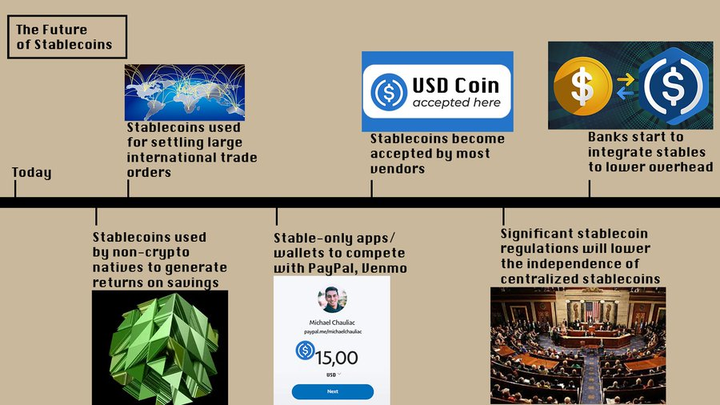
Non-crypto uses of stablecoins: expansion of international transfers and payments
The main non-crypto application of stablecoins is international transfers, and they are increasingly used for payments today. However, as the infrastructure for stablecoins continues to improve and become more popular, they may also be used for savings, especially in developing countries, a trend that has already begun to emerge.
A few weeks ago, @tarunchitra told me a story: In Georgia, a convenience store owner would collect Georgian Lari (GEL) deposited by customers, convert it into USDT and earn interest, while recording customer balances in a simple paper ledger and taking a certain fee from the interest. In this store, customers can also pay using Trust Wallet's QR code. It is worth noting that Georgia's banking system is relatively healthy, but this alternative financial model has still developed here.
In Argentina, the Financial Times (FT) estimates that citizens hold more than $200 billion in cash in USD, all outside the traditional financial system. If even half of the funds were to enter the on-chain or crypto ecosystem, the DeFi market would double in size and the total market value of stablecoins would increase by about 50%—and this is just the potential for one country. Similar situations exist in countries such as China, Indonesia, Nigeria, South Africa, and India, which have large informal economies or a certain degree of distrust in the banking system.
More potential use cases for stablecoins As the use of stablecoins grows, their application scenarios are also expanding.
Credit lending: Currently, stablecoins are mainly used for fully collateralized credit lending, a model that is extremely rare in the global credit market. However, with the introduction of new tools by institutions such as Coinbase, KYC certification data may be used to expand the credit market in the future, and a negative credit record mechanism may be introduced (i.e., failure to repay will affect credit scores).
Profit distribution: Stablecoin issuers are gradually allowing profits to be “passed on” to holders, for example:
USDC offers an annualized return of 4.7%
Ethena’s USDe has a dynamic yield, usually exceeding 10%
Cross-fiat currency transactions: Currently, many transactions are beginning to be conducted in a “double-layer conversion” manner - for example,
A transaction is first converted from local currency to USD stablecoin, and then
Then convert to the target currency (such as Argentine Peso or Nigerian Naira).
This approach means that users need to pay transaction fees twice, but as blockchain technology matures, it may be possible to directly exchange it into stablecoins of the target currency in the future to reduce costs.
As more capital flows into stablecoins, the variety of on-chain financial products will be further enriched, making the application of cryptocurrencies in daily life more mainstream.
8. Challenges facing stablecoins
When discussing the future of stablecoins, we also need to face some overlooked issues.
1) Stablecoins rely on the banking system
Currently, almost all stablecoins rely on bank accounts as their backing assets.
However, the banking system itself is not completely safe. For example:
In 2023, USDC was briefly depegged due to the collapse of Silicon Valley Bank (SVB), demonstrating that even the most trusted stablecoins may be at risk from the banking system.
2) Stablecoins are widely used to circumvent capital controls and money laundering
If you agree that stablecoins can be used to circumvent capital controls and escape the depreciation of local currencies, you have actually acknowledged the fact that such behavior may be classified as money laundering under the local legal framework.
It’s an open secret, but its legal and ethical implications remain underexplored.
3) The freezing and inability to re-issue stablecoins
Currently, neither Circle (USDC) nor Tether (USDT) allows the re-issuance of stablecoins.
If a user's funds are frozen for legal reasons (such as being involved in a crime or determined to be stolen money), those assets will not be returned to the victim, even if the latter has court documents.
This approach is extremely controversial on an ethical level and may even be difficult to sustain in the long run.
4) Government regulatory pressure & CBDC substitution risk
Governments may call for tighter regulation of stablecoins, making them “seizure-able.”
In the long term, central bank digital currencies (CBDCs) could become an official alternative to stablecoins.
This is a broad topic that I will explore in detail in subsequent articles.
9. Truly decentralized stablecoins may be the solution for the future
In the coming years, government regulatory pressure on stablecoins will drive the development of truly decentralized, privacy-preserving stablecoins.
These stablecoins will not be able to be unilaterally frozen or seized by the government and will be completely decentralized.
This could give rise to a new financial technology race, and the development of stablecoins could evolve from regulated financial instruments to truly decentralized currencies.
Of course, this also means new compliance challenges.














